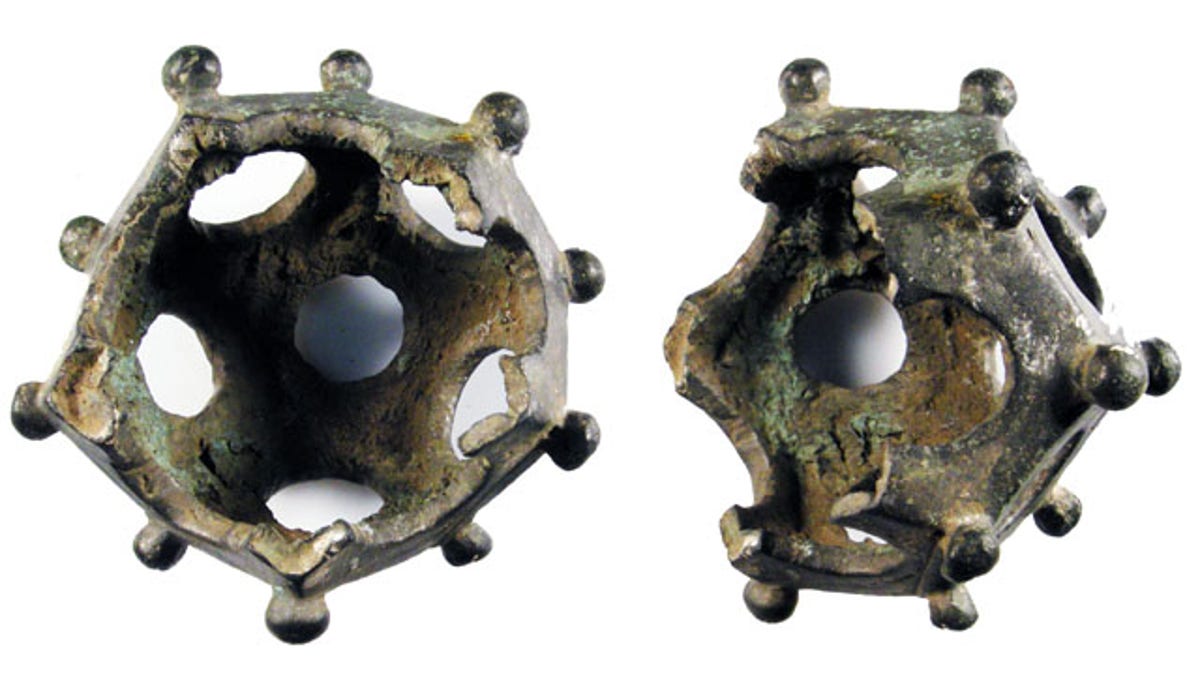
Mysterious, 12-sizeds geometric objects known only as "Roman dodecahedrons" have long mystified archaeologists. (Portable Antiquities Scheme / British Museum)
Can you do what the world's archaeologists can't? Can you explain this -- thing?
It’s been called a war weapon, a candlestick, a child’s toy, a weather gauge, an astronomical instrument, and a religious symbol -- just to name a few. But what IS this mystery object, really?
There are books and websites dedicated to properly identifying it, dissertations dedicated to unveiling the truth, textbooks and class curriculums spent arguing over what its function is. Fans can even “Like” it on Facebook.
Yet the only thing historians will agree on is a name for the odd object: a Roman dodecahedron.
That part was easy, seeing as the mathematical shape of this artifact is a dodecahedron. Best described as a bronze or stone geometric object, it has twelve flat pentagonal faces, each with a circular hole in the middle (not necessarily the same size). All sides connect to create a hollowed out center.
It’s dated from somewhere around the second and third century AD, and has been popping up everywhere in Europe. Archeologists have found the majority of them in France, Switzerland and parts of Germany where the Romans once ruled.
But its use remains a mystery, mostly because the Romans who usually kept meticulous accounts make no mention of it in records. And with sizes varying from 4 to 11 cm, and some bearing decorative knobs, it only gets harder to pinpoint a function.
Speculation among historians has resulted in many different hypotheses, which is as close as we may get to an accurate answer. Few archeologists will even comment on it, because the dodecahedron isn't defined to a specific cultural area and therefore not their area of expertise. Even the theories that do exist are highly debated among historians.
Plutarch, the famous Greek historian reportedly identified the dodecahedron as a vital instrument for zodiac signs. The twelve sides represent the twelve animals in the circle of the Zodiac, but even this theory comes under contest when the argument of the knobs as decoration is presented.
“My take is that it is yet another piece the use of which we shall never completely sort out even though we are fortunate to have Plutarch’s testimony,” said Andrea Galdy, who holds a Ph.D from the School of Art History and Archaeology at the University of Manchester and is currently teaching Art History in Florence, Italy. Galdy has not come across it in her own work, and does not regard herself as a specialist, but she does have plenty of experience in labeling artifacts.
Bloggers from all over the world are stumped as they argue over the purpose of what the different size holes can be used for, and why they are being discovered all over Europe and not in a concentrated area. One was reportedly found in a woman's burial ground, leading many to settle on "religious artifact."
Can you do what archaeologists can't? Can you help solve the mystery?
Email us your thoughts at foxnewstips@foxnews.com. We'll print the best suggestions shortly.




















